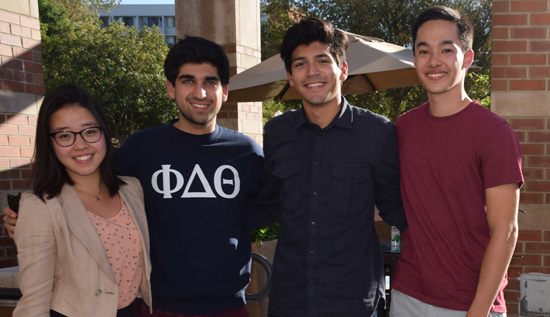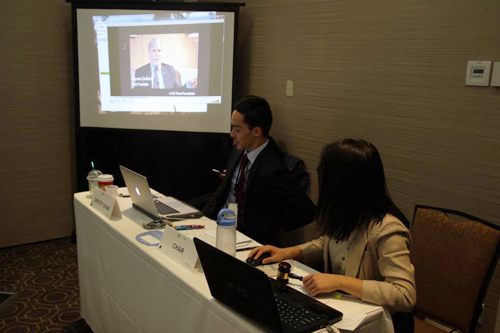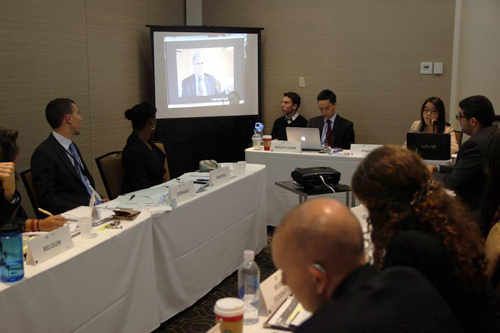First Model UN at USC Uses Rwandan Tutsi Genocide Testimony


(L-R: Jackie Kim, Karan Agarwal, Jazz Advaney, Michael Lim)
University of Southern California students hosted the first-ever Trojan Model UN this weekend, in which college students from around the world gathered to debate world issues in nine thought-provoking committees. One of those committees utilized testimony from the Visual History Archive in order to give the delegates real-life scenarios they couldn’t get anywhere else.
Model UNs are held at universities and high schools worldwide and simulate the experience of being a delegate at the United Nations. Each Model UN, lasting for a few days, features several “committees,” in which a particular current event, historical event, or hypothetical or futuristic event or topic is debated with the intention of coming up with a realistic solution. Each participant assumes the perspective of a delegate from a certain country and must act in the best interest of their country regardless of their personal views on the topic.
At the Trojan Model UN (TrojanMUN), which took place in downtown Los Angeles over Halloween weekend, 15 delegates served on the UN Security Council: Rwanda committee. The committee was set on July 5, 1994, three months after President Habyarimana’s plane was shot down and the Rwandanese Patriotic Front (RPF) had taken over the presidential palace. July was approximately halfway through the crisis, when hundreds of thousands of Rwandans were already displaced.
Throughout the committee session, delegates occasionally received “crisis updates”: surprise reports on new developments from the field. This was where testimony from USC Shoah Foundation’s Visual History Archive came in. The committee chairs showed clips of aid providers and survivors describing violence, rescue efforts and rebuilding in Rwanda during and after the genocide. These clips were meant to introduce the delegates to real people who were involved in the conflict and give the proceedings greater authenticity.
The TrojanMUN organizers said that incorporating testimony into the Rwanda committee would hopefully help the delegates see the Rwandan Tutsi Genocide as an experience that really happened.
“It gets the point across that it was real people doing this. We feel it will be immensely valuable,” said USC sophomore Karan Agarwal, Under Secretary General of TrojanMUN.
 The Rwanda committee is chaired by senior Michael Lim and freshman Jackie Kim. Lim was part of this summer’s Problems Without Passports course in Rwanda, which was led by USC Shoah Foundation associate director of education – evaluation and scholarship Amy M. Carnes. Lim said he wanted to share the personal connection he feels for Rwanda with the delegates and help them have a meaningful, interactive experience.
The Rwanda committee is chaired by senior Michael Lim and freshman Jackie Kim. Lim was part of this summer’s Problems Without Passports course in Rwanda, which was led by USC Shoah Foundation associate director of education – evaluation and scholarship Amy M. Carnes. Lim said he wanted to share the personal connection he feels for Rwanda with the delegates and help them have a meaningful, interactive experience.
“It’s about finding a creative way to tell the story I see in Rwanda in 1994 and later,” Lim said.
While the chairs couldn’t tell the delegates what to do during the committee, they hoped the participants would come up with a resolution to hold perpetrators accountable and end the genocide peacefully.
Simply engaging in a Model UN committee on the Rwandan Tutsi Genocide will also be eye-opening for the delegates. The organizers estimate that each delegate did at least 20 hours of research to prepare for the committee. This alone will increase their awareness of the crisis, its victims and the survivors.
The organizers were also impressed by the level of interest the participants showed for the Rwandan Tutsi Genocide, considering it isn’t an ongoing crisis.
“We’ve been able to attract people who don’t know anything about it but want to learn more about it,” Agarwal said. “Rwanda is kind of a ‘shut case,’ so to be able to attract this kind of attention is something I was surprised at.”
Agarwal and TrojanMUN Secretary General Jazz Advaney said they hope to incorporate more USC Shoah Foundation testimony and resources into future committees of TrojanMUN. Doing so will not only offer participants a richer and more interdisciplinary Model UN experience, but it might also spark their interest in USC Shoah Foundation.
“We’re really fortunate to be able to do this partnership, and having access to the Visual History Archive is exceptionally unique,” Advaney said. “We want to act as a way of engagement. There are people who might be interested [in USC Shoah Foundation] but it just needs to come at them in a different way, and this is one of those ways.”
UPDATE: Delegates watch testimony during the Rwanda Committee at TrojanMUN 2014:

